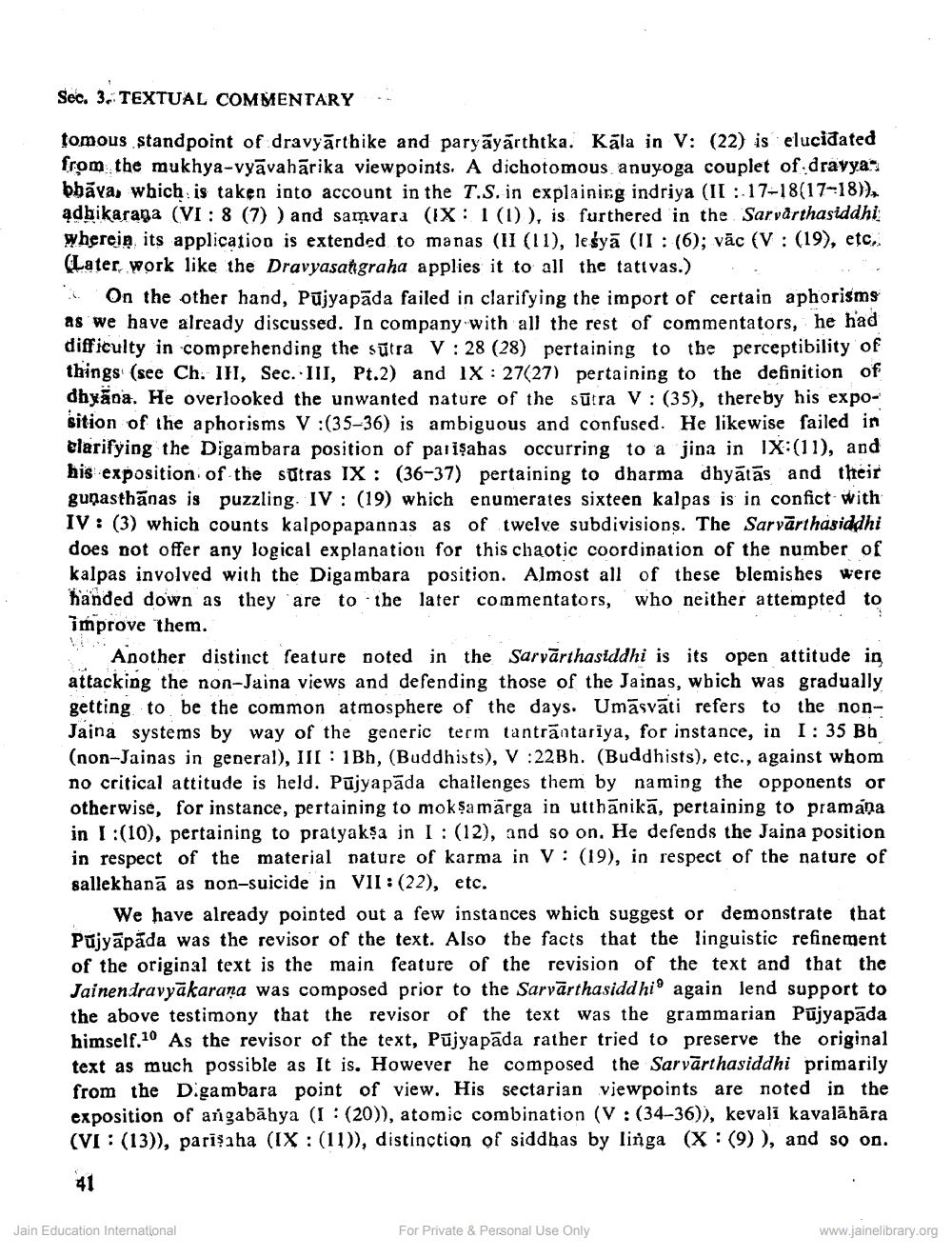________________
Sec. 3. TEXTUAL COMMENTARY
tomous standpoint of dravyārthike and paryāyārthtka. Kāla in V: (22) is elucidated from the mukhya-vyāvahārika viewpoints. A dichotomous anuyoga couplet of dravyaa bbāra, which is taken into account in the T.S. in explaining indriya (II :-17-18(17-18)), adhikaraga (VI:8 (7) ) and saņvara (IX: 1 (1) ), is furthered in the Sarvårthasiddhi wherein its application is extended to manas (II (11), lesyā (II : (6); vāc (V: (19), etc.. Later, work like the Dravyasangraha applies it to all the tativas.) . .
On the other hand, Pūjyapada failed in clarifying the import of certain aphorisms as we have already discussed. In company with all the rest of commentators, he had difficulty in comprehending the sūtra V:28 (28) pertaining to the perceptibility of things (see Ch. III, Sec. III, Pt.2) and IX : 27(27) pertaining to the definition of dhxãoa. He overlooked the unwanted nature of the sūtra V :(35), thereby his exposition of the aphorisms V:(35-36) is ambiguous and confused. He likewise failed in clarifying the Digambara position of parişahas occurring to a jina in IX:(11), and his exposition of the sutras IX: (36-37) pertaining to dharma dhyātās and their gunasthānas is puzzling. IV: (19) which enumerates sixteen kalpas is in confict with IV: (3) which counts kalpopapannas as of twelve subdivisions. The Sarvārthasiddhi does not offer any logical explanation for this chaotic coordination of the number of kalpas involved with the Digambara position. Almost all of these blemishes were handed down as they are to the later commentators, who neither attempted to improve them.
Another distinct feature noted in the Saryārthasiddhi is its open attitude in attacking the non-Jaina views and defending those of the Jainas, wbich was gradually getting to be the common atmosphere of the days. Umāsvāti refers to the nonJaina systems by way of the generic term tantrāntariya, for instance, in I: 35 Bb (non-Jainas in general), III : 13h, (Buddhists), V :22Bh. (Buddhists), etc., against whom no critical attitude is held. Pujyapāda challenges them by naming the opponents or otherwise, for instance, pertaining to moksamārga in utthānikā, pertaining to pramaņa in 1:(10), pertaining to pratyaksa in I : (12), and so on. He defends the Jaina position in respect of the material nature of karma in V: (19), in respect of the nature of sallekhanā as non-suicide in VII: (22), etc.
We have already pointed out a few instances which suggest or demonstrate that Pujyāpāda was the revisor of the text. Also the facts that the linguistic refinement of the original text is the main feature of the revision of the text and that the Jainendravyākaraṇa was composed prior to the Sarvārthasidd hi' again lend support to the above testimony that the revisor of the text was the grammarian Pūjyapāda himself.10 As the revisor of the text, Pūjyapāda rather tried to preserve the original text as much possible as It is. However he composed the Sarvārthasiddhi primarily from the Digambara point of view. His sectarian viewpoints are noted in the exposition of argabāhya (1 : (20)), atomic combination (V :(34-36)), kevali kavalähāra (VI : (13)), parisaha (IX :(11)), distinction of siddhas by linga (x: (9)), and so on.
41
Jain Education International
For Private & Personal Use Only
www.jainelibrary.org




